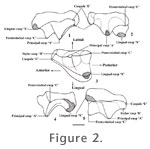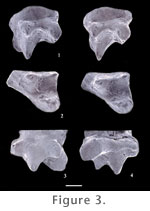|
|
SYSTEMATICS
Order DOCODONTA Kretzoi, 1946 Generic Diagnosis. Upper premolariform (possibly P3) tooth with an asymmetrically triangular, transversely wide crown bearing two main labial cusps and one lingual cusp, separated by a talon basin, and two small cuspules form the protruding anterior angle of the tooth. The tooth differs from the upper molars of all known docodont taxa in having labial cusps with diverging tips that are separated by a broad notch, a less steeply sloping labial face of lingual cusp X, the absence of a posterior lingual cusp Y, asymmetrical occlusal outline, and absence of a talon basin anterior to the crest from the cusps A to X. Differs from the P3 of Haldanodon in the presence of two anterolabial cuspules and a well-developed lingual part of the crown with an anteroposteriorly wide lingual cusp. Differs from the P3 of Docodon superus Simpson 1929 in its more developed lingual part with a large cusp and in the presence of two anterolabial cusps, B and E. Etymology. Genus named in honour of the Gond tribe of people inhabiting the area where the fossiliferous section is exposed, and therion – Greek for beast. Type Species. Gondtherium dattai sp. nov. Holotype. - VPL/JU/KM/12, left ultimate upper premolar (P3) (pseudotribosphenic-like mammal of Prasad and Manhas 1999) Horizon and locality. Mudstones associated with the limestone horizons of the Upper Member of the Kota Formation, Upper Gondwana Group, exposed along a stream cutting 150 m west of Paikasigudem village, Rebbana Mandalam, Adilabad District, Andhra Pradesh (State), India. Specific Diagnosis. Same as for the genus. Etymology. Species named after Mr. P.M. Datta, Director, Geological Survey of India, who described the first mammal from the Kota Formation.
A lingually extended talon with a large, stout and anteroposteriorly long lingual cusp X, lower than A but higher than C, is present (Figure 2.1-2.4, Figure 3.1-3.4). This robust lingual cusp is separated from A by a deep basin. A completely worn crest descends lingually from the tip of A to the middle of its base and might have extended to the lingual cusp in the unworn condition. As the crown is spalled off in this area, this connection of A with X cannot be ascertained; only a weak trace of crest exists lingual to the base of A (Figure 2.3). The deep talon lies posterior to this weak trace of crest and occupies the space between the lingual junction of the labial cusps and the labial base of X, which slopes posterolabially (Figure 3.1-3.2). A highly worn cingular crest extends from the posterolabial tip of X to the lingual base of C. Another crest extending from the tip of X forms a gentle anterolabial slope and terminates at the lingual base of E. This crest is situated at a higher level than the posterior crest and forms a discrete anterior cingulum. The anterolingual face of X is convex dorsally but becomes flat ventrally and has a relatively larger area than the posterolingual face, which is also convex; the latter shows some sort of enamel chipping. The posterior face of the tooth is nearly at right angle to the labial face, whereas the anterior face is very obliquely oriented to it (Figure 2.3, Figure 3.2). The tooth is pinched at the lingual base of the labial cusps, particularly on the posterior face of the crown (Figure 3.2). Wear facets are not discernible as the enamel is not preserved. The roots are not preserved, but from the broken dorsal surface it appears that there were probably three roots. The pulp chamber is widely open and has a smooth surface and rounded edges as in permanent teeth. |
|

